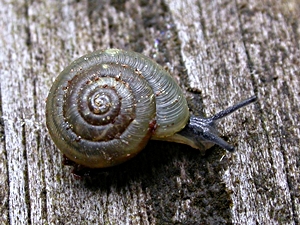
Elliott's gloss snail (Zonitoides elliotti) from Tennessee.
Picture: John Slapcinski, (Source).
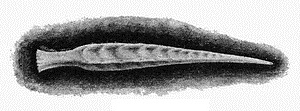
"Love dagger" of the British gloss snail (Zonitoides exca-
vatus). Source: Taylor, J. W. (1894-1914).
 Elliott's gloss snail (Zonitoides elliotti) from Tennessee. Picture: John Slapcinski, (Source). |
|
 "Love dagger" of the British gloss snail (Zonitoides exca- vatus). Source: Taylor, J. W. (1894-1914). |
The Gastrodontidae family of gloss snails in their external appearance are similar to true glass snails (Zonitidae etc.). Systematically, today, the Gastrodontidae, together with some true glass snails (Oxychilidae) and the hive snails (Euconulidae) are placed in a joint superfamily, Gastrodontoidea.
Class:
Gastropoda
![]() Subclass:
Pulmonata
Subclass:
Pulmonata
![]() Superorder:
Eupulmonata
Superorder:
Eupulmonata
![]() Order:
Stylommatophora
Order:
Stylommatophora
![]() Suborder:
Sigmurethra
Suborder:
Sigmurethra
![]() Infraorder:
Arionoinei
Infraorder:
Arionoinei
![]() Superfamily:
Gastrodontoidea
Superfamily:
Gastrodontoidea
![]() Family:
Gastrodontidae Tryon 1866
Family:
Gastrodontidae Tryon 1866
![]() Source: Mollbase on
http://www.mollbase.de/list/, Fauna Europaea on
http://www.faunaeur.org.
Source: Mollbase on
http://www.mollbase.de/list/, Fauna Europaea on
http://www.faunaeur.org.
![]() Relatives of glass snails (Vitrinoidea).
Relatives of glass snails (Vitrinoidea).
Special about the Gastrodontidae is a "dart-like calciferous stimulation organ, called a "love-dagger" (Falkner, 1990, p. 170), to which this snail family owes its German name "dagger snails", as well as its scientific name. In Gastrodontids, the dart sac with this love dagger is connected to the lower part of the penis, and so naturally is located in the male part of the genital apparatus, whereas, in most other snails, dart sac and love dart have developed in the female part of the genital apparatus (see also: The Love Dart).
Most species from the Gastrodontidae family, whose distribution is holarctic (see: Faunal provinces of the Earth), are small or tiny snails with a shell size between some millimetres and a centimetre. In North America, there are several species, there are also some found in Central America, the Canary Islands and Madeira. In Europe, three species are native and one species is an introduced so-called greenhouse species. The snails usually live in the vicinity of water.
Black Gloss Snail - Zonitoides nitidus (O. F. Müller 1774)
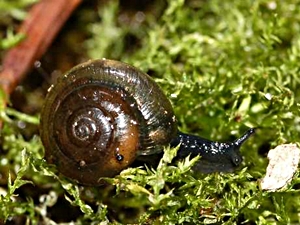 Black gloss snail (Zonitoides nitidus) from Iowa. Picture: Harlan Ratcliff, Poweshiek Skipper Project. |
Description: The black gloss snail has a reddish brown shell with radial growth lines. The shell navel (umbilicus) is very wide - it takes almost a quarter of the shell diameter.
The snail itself is very darkly coloured. The characteristic orange coloured mantle gland can be seen though the translucent shell near the aperture. Juvenile specimens are whitish grey with translucent light brown shells.
Dimensions: H: 3.5 - 4 mm; W: 6 - 7 mm; N: 4¾ - 5. (Abbreviations).
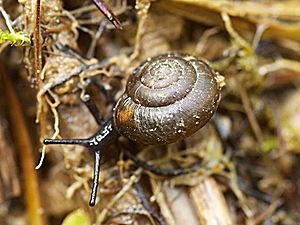 Black gloss snail (Zonitoides nitidus) from the canton of St. Gallen (Switzerland). Picture: © S. Haller, (schneckenfoto.ch). |
Habitat and Distribution: The black gloss snail prefers humidity and so it is often found near water, on wet meadows and in alluvial forests, also on vegetation standing in the water. Zonitoides nitidus is also a snail species to occupy anthropogenous habitats, such as closed-down flooded quarries.
In spite of its external resemblance with glass snails, Zonitoides nitidus is a herbivore. The snails feed on decaying leaves, mushrooms, roots and fruit, preferring wet leaves. When eating mushrooms, the snails leave a characteristic feeding trace - the gnaw deep holes into the mushroom, in which the complete snail including the sell can disappear.
The black gloss snail has a holarctic distribution and can be found in all of Europe, with the exception of the far south. It becomes rare in northern Greece and in the Scottish and North English highlands. It is absent in North Scotland and the adjacent islands. Introduced, the black gloss snail has been to Minorca.
Threat Situation: In some parts of Great Britain, the populations of black gloss snails are declining because of the drainage of their habitats.
![]() Francisco
Welter-Schultes:
Zonitoides nitidus species homepage.
Francisco
Welter-Schultes:
Zonitoides nitidus species homepage.
![]() Mollbase:
Zonitoides (Zonitoides) nitidus (Glänzende Dolchschnecke)
(In German)
Mollbase:
Zonitoides (Zonitoides) nitidus (Glänzende Dolchschnecke)
(In German)
Quick Gloss Snail - Zonitoides arboreus (Say 1816)
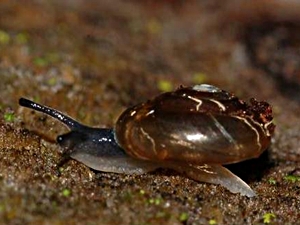 Quick gloss snail (Zonitoides arboreus) from Iowa. Picture: Harlan Ratcliff, Poweshiek Skipper Project. |
Description: The quick gloss snail has a light brownish yellow translucent shell, striated weakly and irregularly. The whorls sometimes are slightly keeled. The shell navel (umbilicus) is deep, but much narrower than in Zonitoides nitidus, only about one seventh of the shell diameter.
The snail itself is typically bicoloured: The back, the tentacles and the upper flanks are bluish grey, the lower flanks and the foot sole are light grey.
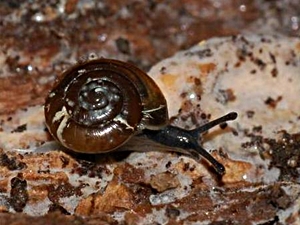 Quick gloss snail (Zonitoides arboreus) from Iowa. Picture: Harlan Ratcliff, Poweshiek Skipper Project. |
Dimensions: H: 1,7 - 3 mm; W: 4,5 - 6 mm; N: 4 - 4½. (Abbreviations).
Habitat and Distribution: The quick gloss snail lives in forest habitats (the scientific name means "tree gloss snail"), as well as in humid places in different altitudes. Also, it is found in anthropogenic habitats, such as gardens. Generally, Zonitoides arboreus prefers drier habitats than does Zonitoides nitidus. From Montana the species has been reported from an altitude of 1471 m MSL.
In North America, the quick gloss snail is more frequent than the black gloss snail. It is widely common: It is present from British Columbia in the west of Canada to Newfoundland in the east, through the United States to Mexico and further south until Costa Rica in Central America. In Europe, on the contrary, the quick gloss snail is a so-called green house species, which is introduced mainly with imported plants and usually is found in and near green houses. Especially on orchid plants the snails can often be observed, where they can inflict considerable damage by eating the roots. Introduced the species has been to Iceland and Sweden, Austria and Hungary, Germany and Switzerland, as well as from other parts of the world (Australia, Kamchatka, Japan, Hawaii, Israel and South Africa).
Escaped specimens may be able to survive quite well in the European nature. Populations in nature are very little researched. There are more current reports of populations in nature from Sweden (1956, 2003), Hungary (2001), Mecklenburg-West Pomerania (2003) and the Czech Republic (2007). Older reports (before 1920) mention Finland, Russia and Ireland.
|
|
Francisco Welter-Schultes: Zonitoides arboreus species homepage. | |
|
|
Robert G. Forsyth et al.: Terrestrial Gastropods of the Columbia Basin, British Columbia: Family Zonitidae. | |
|
|
Wolfgang Fischer et al.: Check List of Austrian Mollusca. | |
|
|
Mollbase: Zonitoides (Zonitoides) arboreus (Gewächshaus-Dolchschnecke). (In German) | |
|
|
Jacksonville Shell Club: Zonitoides arboreus (Quick gloss) in Florida (Florida Land Snails Gallery). | |
|
|
Jueg, U.; von Proschwitz, T. (2003): Ein Freilandfund von Zonitoides arboreus (Say 1816) im Landkreis Ludwigslust (Mecklenburg-Vorpommern). - Mitt. dtsch. malakozool. Ges. 69/70 15 - 19 (PDF). (in German) | |
|
|
Dvořįk, L.; Kupka, J. (2007): The first outdoor find of an American snail Zonitoides arboreus (Say, 1816) from the Czech Republic. - Malacologica Bohemoslovaca (2007), 6: 1 - 2 (PDF). |
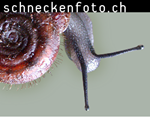 With pictures by Stefan Haller: http://www.schneckenfoto.ch. |